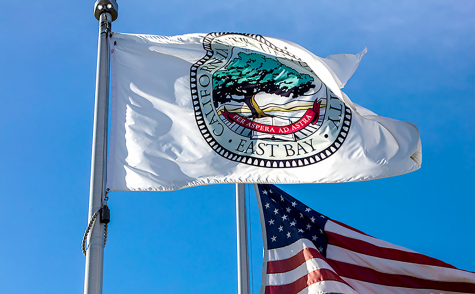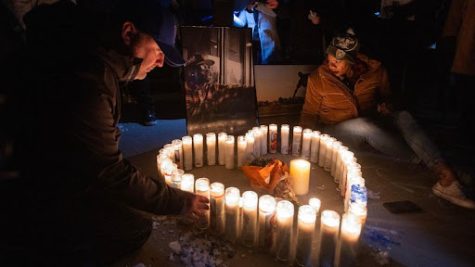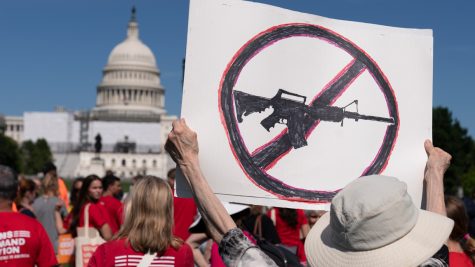Precautions to take if there’s an active shooter
Run, hide or fight?
In the event of an active shooter: run, hide, fight.
Hidden within this seemingly simple set of instructions lies a spectrum of subtext and a wealth of information. There is a time to run, a place to hide, and a reason to fight. Knowing when and how to do each can potentially save your life.
On a national scale, the Hayward area is not known for gun violence, but the threat of an active shooter on campus is nonetheless very real. Just recently in Kentucky, a fifteen-year-old high school student killed two students and injured eighteen more. It is the 11th school shooting, according to The New York Times. East Bay students have reason to think about being prepared.
Running away is advised to all who can hear shots from afar, although it may be difficult to estimate what direction shots are coming from and where they are heading. At any time, students should know all of the exits and entrances of the building they are in and pay close attention to emergency exits. When shots are closer, knowing how and where to run is vital.
“Get off the X,” said John Lovell, a former member of Special Operations and 2nd Ranger Battalion, who now teaches personal defense, room clearing, night vision classes, and a variety of weapon courses, in an interview. “Get away from the mass of people. Whatever direction everyone is running, you do not want to be running in that direction.”
The “X,” according to Lovell, is where the shooter has planned the attack. The aim in running is to remove oneself from the ambush and look for cover and concealment.
Concealment means being out of the shooters line of sight, whereas cover provides both concealment and protection from incoming gunfire. Know where to head for each, and understand the difference between the two. Bushes, walls, and vehicles offer concealment, but concrete and steel (depending on the thickness) provide cover.
Copy-rooms make for ideal hiding spots, because a student or faculty member can barricade the door with heavy copy machines, according to CHP Officer Sean Wilkenfeld, who teaches classes on what to do in the event of an active shooter in an office building. Wilkenfeld also mentions that although copy room walls may only slow down bullets, the walls are lined with paper and still make for better protection than regular walls.
“Whatever you can find to put between yourself and the shooter, the better off you’re going to be,” said Wilkenfeld in an interview. Physical barriers present inconveniences for the attacker, and they may choose to abandon the area altogether. If the attacker is persistent, a barricade may slow them down until either law enforcement arrives.
Fighting is the last option and is not recommended, but drastic times call for drastic measures. “If you have no other option and you can fight, you can be the one to stop that shooter,” said Wilkenfeld.
Common tools, which can be found in any classroom or office building, make handy weapons. A fire extinguisher, can be used in self-defense and not just as a bludgeoning weapon.Wilkenfeld speaks from past experience when he says that being sprayed in the face with a fire extinguisher “will literally take your breath away.”
The powder of a fire extinguisher can be inhaled and potentially coat the lungs of the person, making it extremely difficult for them to receive oxygen, which makes it an effective last resort self-defense weapon at close range. “The best thing you can have at your disposal is the element of surprise to counterattack,” said Lovell. “If I’m at arms length, I’d recommend aiming at something soft and squishy like a trachea or an eye socket.”
Any everyday carry item, such as a pen, a flashlight or a set of keys can also work as a last resort. But how many college students actually feel prepared for this type of situation, or have actually considered the scenario as a real-life possibility?
“In that instance the only thing that we could do was to get everybody around us and ourselves out,” said 22-year-old Asael Hernandez, who experienced what he thought at the moment was an active shooter scenario. It turned out to be a false alarm, triggered by mistaken reports of a man with a gun inside Southland Mall, but the experience stuck with him. “Turns out that a lot of people freeze in situations like that, so we had to pull people with us,” said Hernandez.
It’s not uncommon for individuals to freeze up in high-stress situations like these, which is why being situationally aware is so important. This is not to be mistaken with paranoia, it is a state of constant readiness, not fear. The point is that it never hurts to stop and think ahead before it’s too late..
“The body cannot go where the mind has not gone already,” said Lovell. “Translation: If you haven’t already thought about what you would do in the myriad of just different things that could happen, there’s a huge likelihood that you are just going to freeze.”










